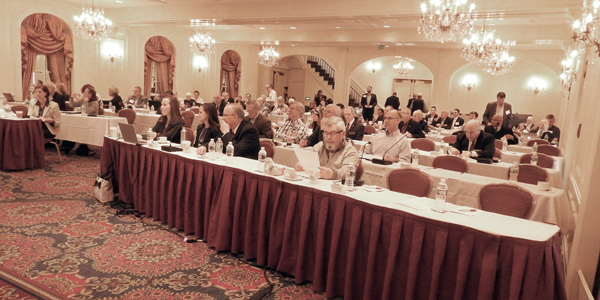By Michael Kuser
NEW CASTLE, N.H. — More than 100 people gathered with ISO-NE’s Consumer Liaison Group (CLG) at the historic Wentworth by the Sea hotel to discuss the rapid changes overtaking New England’s electricity market.
The CLG holds quarterly meetings around the region to provide a chance for residents, state officials and energy experts to learn more about the grid operator.
CLG Chair Rebecca Tepper, chief of the energy and telecommunications division in the Massachusetts attorney general’s office, said the group is “thinking about additional opportunities for members of the CLG to talk directly to ISO New England professionals and staff, just so there’s more direct communication available.”
Here’s more of what we heard at the CLG’s most recent meeting.
From Consumer Boon to Market Boom

New Hampshire Public Utilities Commissioner Michael Giaimo said that New England’s market restructuring has benefited consumers.
“No longer can a utility build a generation facility solely on the backs of ratepayers,” Giaimo said. “The system of captive ratepayers being susceptible to stranded costs has been replaced by developers and their shareholders bearing the risks and the rewards associated with building, operating and maintaining a generation facility.”
Anne George, ISO-NE vice president for external affairs, said the RTO’s 2017 average wholesale energy prices were the second lowest since 2003, while last month’s Forward Capacity Auction 12 marked the third consecutive decline in clearing prices. (See ISO-NE Capacity Prices Hit 5-Year Low.)
George reiterated the RTO’s concerns about fuel security, a challenge brought home during two bitter cold weeks around New Year’s Day when New England generators burned through nearly 2 million barrels of oil, more than twice the amount used by the region’s power plants during all of 2016. (See Van Welie: ISO-NE in ‘Race’ to Replace Retirements.)
Giaimo noted that the cold snap saw the value of the region’s energy transactions surge to about $1.1 billion during the first three weeks of January, equal to 25% of the entire energy market value in 2015. (See FERC, RTOs: Grid Performed Better in Jan. Cold Snap vs. 2014.)
Markets Misalignment
Jonathan Peress, director of energy market policy at the Environmental Defense Fund, said the Northeastern power price spike observed Jan. 5 was not driven by New England gas pipeline constraints but by New York City power demand, which was symptomatic of a misalignment between gas and electric pricing.
“Very high LNG sendout kept Algonquin [gas hub] prices lower than would otherwise have been the case on Jan. 5,” Peress said. “LNG was the key resource that allowed consistent access to gas.”
The value of gas supply and pipeline delivery service fluctuates over the course of the day, but the gas market primarily relies on a single daily index price. Non-ratable takes are valuable to generators, but the variable flow and pipeline flexibility service is not priced, he said.
“It’s really not good to be relying on 50-year-old oil steam boilers for our reliability in New England,” Peress said. “I used to manage some of them — not pretty.”
New Hampshire Sen. Andy Sanborn (R) said “virtually every woe you have, when it comes to your ability to run your company and energy policy, actually solely starts at the legislature.”
The legislature controls the energy conversation, and discussion ends up being a debate between left and right, Sanborn said, when the region has systemic problems.
“It is specifically the legislature that determines whether we’re going to let that market run freely, all the way from our ability to sign off on long-term plan purchase contracts … to what percentage of our business needs to be renewable or non-renewable, and whether or not we are allowing companies to bring gas in or bring power down,” Sanborn said.
Market-Based Solutions
Carl Gustin, a communications strategist with consultancy Salient Point, brought a historical perspective to the discussion by recalling how the 1978 Power Plant and Industrial Fuel Use Act banned the use of natural gas by power plants.
The first energy-efficiency measures elicited disbelief among utility executives who could not envision “un-selling” their product.
“We called it conservation back then,” Gustin said.
But now: “You’ve got renewables coming up and coming on quickly and you’ve got to manage that system both for voltage and for reliability,” Gustin said. “You’ve got a big problem in front of you.”
Tanya Bodell, executive director of consultancy Energyzt, said that, coming from the Chicago school of economics, she always favors market-based solutions.
“Right now, there’s not an incentive through the price signal for most customers to adjust their consumption, so we’re really not tapping into the demand response,” Bodell said. “And customers can make money — those who are able to make those adjustments. I would say that’s a market solution.”
Pricing carbon is another market-based solution, she said.
“If you put a price on carbon, the cost of the oil-fueled units will become more expensive and other alternatives, LNG for example, can come in and help to solve that. We saw LNG flowing into New York. If the price signal is there, it will come.”






